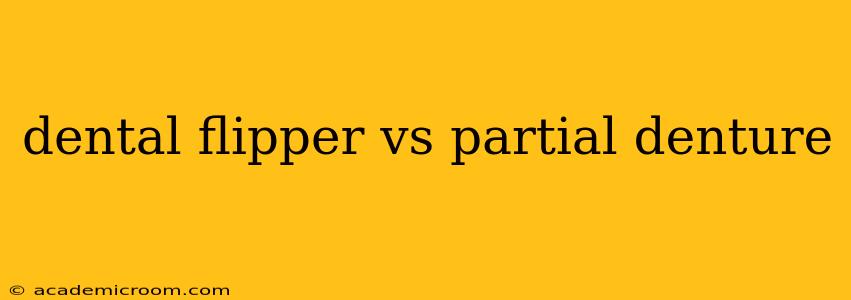Losing teeth can be a challenging experience, impacting both your confidence and your ability to eat comfortably. Fortunately, modern dentistry offers several solutions to restore your smile and oral function. Two popular options are dental flippers and partial dentures. While both serve a similar purpose – replacing missing teeth – they differ significantly in their design, longevity, and cost. This comprehensive guide will delve into the key differences between dental flippers and partial dentures, helping you make an informed decision about which is best for your individual needs.
What is a Dental Flipper?
A dental flipper, also known as an immediate denture or a temporary partial denture, is a removable appliance designed to replace one or a few missing teeth. It's typically made from acrylic resin and is much less expensive and faster to produce than a partial denture. Its primary purpose is to provide immediate tooth replacement following an extraction or while awaiting a more permanent solution like a bridge or implant. Because of its temporary nature, a flipper is not as durable or aesthetically pleasing as a partial denture.
What is a Partial Denture?
A partial denture is a removable appliance designed to replace multiple missing teeth. Unlike a flipper, a partial denture features a metal framework that provides superior strength and support. This framework is usually made of cast metal (often chrome cobalt alloy) and clasps onto existing teeth to help secure it in place. The teeth are then attached to this framework, usually made of a durable acrylic resin. Partial dentures offer a more stable and long-lasting solution compared to flippers.
Dental Flipper vs. Partial Denture: Key Differences
Here's a table summarizing the core differences:
| Feature | Dental Flipper | Partial Denture |
|---|---|---|
| Cost | Significantly less expensive | More expensive |
| Material | Primarily acrylic resin | Metal framework with acrylic teeth |
| Durability | Less durable; prone to breakage and wear | More durable; longer lifespan |
| Esthetics | Less aesthetically pleasing; may look bulky | More natural-looking; better fit and aesthetics |
| Retention | Can be loose; less secure | Generally more secure; better retention |
| Treatment Time | Faster production time | Longer production time |
| Suitable For | Temporary solution; replacing few missing teeth | Replacing multiple missing teeth; long-term solution |
How Long Does a Dental Flipper Last?
A dental flipper is designed as a temporary solution. Its lifespan typically ranges from several months to a couple of years, depending on wear and tear and individual oral hygiene practices. With proper care, a flipper might last longer, but it will eventually need replacement.
How Long Does a Partial Denture Last?
With proper care and regular maintenance, a partial denture can last for five to ten years or even longer. However, regular check-ups and adjustments with your dentist are crucial to ensure its continued proper fit and function. Wear and tear, such as damage to the acrylic teeth or the metal framework, will eventually require repairs or replacement.
Which is Better: Flipper or Partial Denture?
The best option – flipper or partial denture – depends entirely on your individual needs and circumstances. A flipper is a cost-effective temporary solution ideal for replacing a small number of missing teeth while awaiting a more permanent solution. A partial denture, while more expensive, provides a more durable, aesthetically pleasing, and long-lasting solution for replacing multiple missing teeth.
What are the Pros and Cons of Each?
Dental Flipper:
Pros:
- Inexpensive
- Fast turnaround time
- Simple to make
Cons:
- Less durable
- Can be bulky and uncomfortable
- Poor aesthetics
- Shorter lifespan
Partial Denture:
Pros:
- More durable
- Better aesthetics
- More comfortable fit
- Longer lifespan
- Better retention
Cons:
- More expensive
- Longer production time
- Requires more maintenance
Are there alternatives to flippers and partial dentures?
Yes, there are other options for replacing missing teeth, including dental implants, dental bridges, and dentures. Dental implants are permanent replacements that fuse with the jawbone, providing the most stable and long-lasting solution. Dental bridges replace missing teeth by anchoring artificial teeth to adjacent natural teeth. Full dentures replace all the teeth in an arch. Your dentist can help determine the best option for your specific situation.
This comprehensive comparison of dental flippers and partial dentures provides a thorough understanding of each option. Remember to consult your dentist to determine the most suitable solution for your individual needs and oral health. They can assess your specific situation, discuss the various treatment options, and help you make an informed decision.
